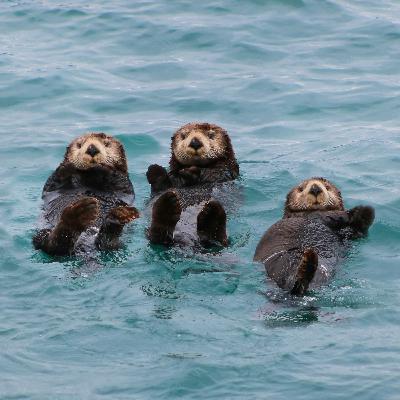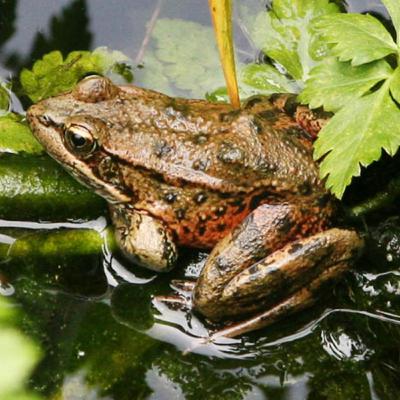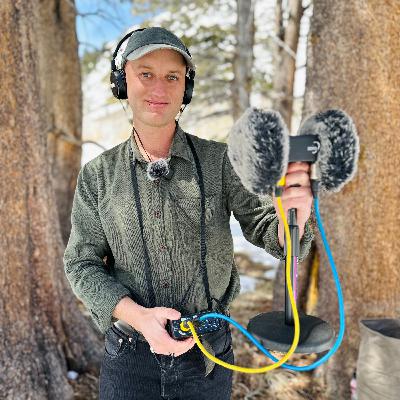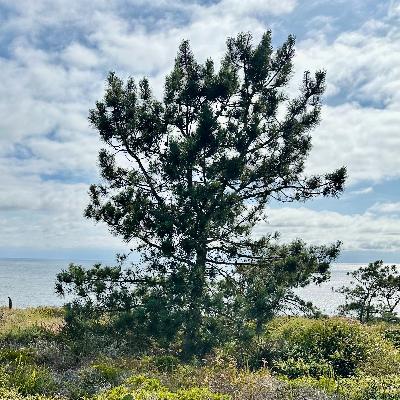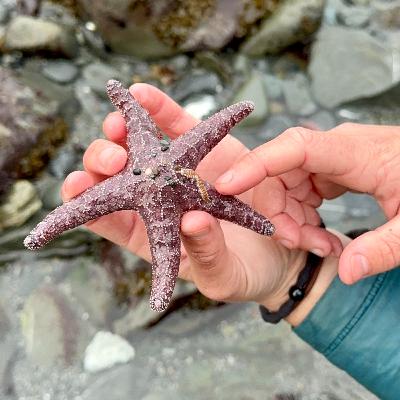Discover Golden State Naturalist
Golden State Naturalist
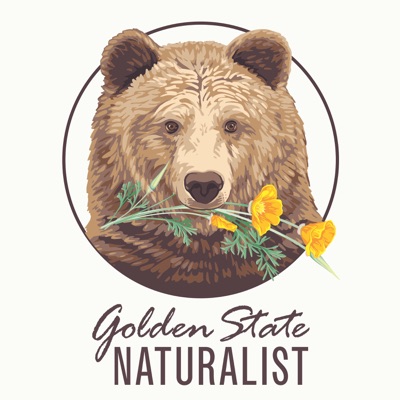
Golden State Naturalist
Author: Michelle Fullner
Subscribed: 134Played: 2,353Subscribe
Share
© Michelle Fullner
Description
Golden State Naturalist is a love letter to California's ecological past, present, and future.
Come with Michelle Fullner as she climbs to the top of a beaver dam, descends into a tar pit, peers into the canopy of a giant sequoia, and basks in the glow of the Milky Way under the eerie silhouettes of Joshua trees.
Each episode, Michelle interviews captivating experts in their natural habitats across California to find out how the unique plants, animals, geology, and hydrology of this biodiversity hotspot make this state Golden.
Come with Michelle Fullner as she climbs to the top of a beaver dam, descends into a tar pit, peers into the canopy of a giant sequoia, and basks in the glow of the Milky Way under the eerie silhouettes of Joshua trees.
Each episode, Michelle interviews captivating experts in their natural habitats across California to find out how the unique plants, animals, geology, and hydrology of this biodiversity hotspot make this state Golden.
64 Episodes
Reverse
Can cities be good for wildlife? Or at least not so bad? What changes would we need to make to welcome more life into our cities? How would those changes impact humans? What are other cities already trying? Come with me and Kat Superfisky to the largest city in California, where we discuss all of this and so much more. Note: This interview was recorded in September of 2024, so any references to the Federal government are references to the government during the Biden Administration. Helpful Links: Kat’s website Content Creation for NatureSupport Golden State Naturalist on Patreon and get perks starting at $4/month. Follow me on Instagram. My website is goldenstatenaturalist.com. Get podcast Merch. The theme song is called “i dunno” by grapes and can be found here.
California is one of only 36 Global Biodiversity Hotspots. This means that we have incredible species richness with at least 1,500 endemic vascular plant species. But here's the bummer. In order to be considered a Global Biodiversity hotspot, a place must also be threatened. So threatened, in fact, that it must have only 30% or less of its original natural vegetation remaining.
Oof.
Thankfully, Californians are not sitting idly by waiting for the rest of our biodiversity to disappear. Across the state, conservation leaders, on both small and large scales, are pulling together and protecting the places that matter to us most.
In this special episode, come with me behind the scenes of this year's 30x30 Partnership Summit to talk with those leaders, hear about some of today's most inspiring conservation success stories, and discover how you can be part of the movement to protect California for generations to come.
Helpful Links:
30x30 Official Website
Valérie Courtois's TED Talk
Carr Lake in Salinas
Support Golden State Naturalist on Patreon and get perks starting at $4/month.
Follow me on Instagram.
My website is goldenstatenaturalist.com.
Get podcast Merch.
The theme song is called “i dunno” by grapes and can be found here.
Otter photo by Kedar Gadge on Unsplash.
Chances are, you’ve never seen our state amphibian in the wild. In this episode, find out how the California red-legged frog became so rare while also delving into international border crossings with endangered frog eggs, urban drool, The Celebrated Jumping Frog of Calaveras County, things that can fit into a bullfrog’s mouth, and the essential mindset shift that might just change the world. Join me and Brad Hollingsworth from the San Diego Natural History Museum as we discuss all of this and so much more. Links: Trivia Night! Join me in-person on May 12th or online on May 27th for Quiz for a Cause, a fundraiser to help rebuild the Eaton Canyon Nature Center. And check out the silent auction here! Saving the California red-legged frog from extinctionFAUNO: Fanua del Noroeste. Learn more about the work in Mexico or sign up for a workshop. ECOS information on red-legged frog federal listing Support Golden State Naturalist on Patreon and get perks starting at $4/month. Follow me on Instagram. My website is goldenstatenaturalist.com. Get podcast Merch. The theme song is called “i dunno” by grapes and can be found here.Episode cover photo courtesy of the San Diego Natural History Museum.
How can listening deepen our relationship with place? What do birds think about highway noise? Is that ice bridge safe to cross at this time of year? How can I learn to listen more closely? Join me and Fil Corbitt as we snowshoe down the Eastern slope of the Sierra Nevada Mountains in search of a handmade desk and a place to listen to flowing water, to birdsong, to each other, and to the ever-changing landscape itself. Links: Fil's podcast is called The Wind. Check out their Coyote episode. "Birdsongs alleviate anxiety and paranoia in healthy participants"Support Golden State Naturalist on Patreon and get perks starting at $4/month. Follow me on Instagram. My website is goldenstatenaturalist.com. Get podcast Merch. The theme song is called “i dunno” by grapes and can be found here.
What do cacti and rare pines have in common? What’s a paleoendemic? Do pinecones have teeth? Why do so many different plant species live in Mediterranean climates? Join me and Jon Rebman as we go behind the scenes of the San Diego Natural History Museum, explore the herbarium, and discuss the rarest pine species in North America. Links: San Diego Natural History MuseumUniversity of California Museum of PaleontologyCool study about redwood leavesInfo about Torrey pines and bark beetlesSupport Golden State Naturalist on Patreon and get perks starting at $4/month. Follow me on Instagram. My website is goldenstatenaturalist.com. Get podcast Merch. The theme song is called “i dunno” by grapes and can be found here.
Have you ever wondered what little-known and mysterious beings are living among us, just out of sight? This episode is about one such creature that most Californians have no idea even exists.
Join me, Dave Wyatt, and Kristyn Schulte as we discuss clever little foxes, oak mistletoe, the floor is lava, dissolved poop, the smallest mountain range in the world, tasty taxidermy, classroom design, convergent evolution, weasel lemurs, and a whole lot more.
Links:
The California Ringtail Project
Mistletoe toxicity
Support Golden State Naturalist on Patreon and get perks starting at $4/month.
Follow me on Instagram.
My website is goldenstatenaturalist.com.
Get podcast Merch.
Subscribe to the GSN email newsletter.
Episode cover photo by Dave Wyatt.
The theme song is called “i dunno” by grapes and can be found here.
Join me and Dr. Alexandra Syphard as we discuss what makes some neighborhoods more fire prone than others, the Santa Ana Winds, defensible space, the massive differences between fires in forested Northern California and shrubby Southern California, the pendulum swing of public opinion, ways that climate change does and doesn’t contribute to wildfires, the WUI, positive uses of abandoned Fry's electronics buildings, waxy leaves, invasive plants, and so much more.
This episode is an attempt to add context for everyone struggling to comprehend the scale of the fires in Los Angeles, especially those impacted. I hope it helps. Sending love.
Links:
California Fire Hazard Severity Zones
Support Golden State Naturalist on Patreon and get perks starting at $4/month.
Follow me on Instagram.
My website is goldenstatenaturalist.com.
Get podcast Merch.
The theme song is called “i dunno” by grapes and can be found here.
Cover art by Raquel Raclette.
Flying over San Diego, you can see them: Fingers of green extending through neighborhoods all across the city.
San Diego’s urban canyon’s serve as refuges for people and wildlife alike, but they’re also often isolated islands of habitat. This can keep animals from accessing the resources they need to survive. And human neighbors aren’t always able to access these spaces, either.
In this episode, join me and Michelle Thompson as we search for reptiles in one of San Diego’s urban canyons, discuss what makes canyons special, and explore how the San Diego Natural History Museum is setting the foundation for the long-term health of these spaces.
Links:
Healthy Canyons Initiative
Go on a FREE hike with the Canyoneers
Want to help SD canyons? Email Michelle Thompson at: conbio@sdnhm.org
1988 Michael Soulé Study
Support Golden State Naturalist on Patreon and get perks starting at $4/month.
Follow me on Instagram.
My website is goldenstatenaturalist.com.
Get podcast Merch.
The theme song is called “i dunno” by grapes and can be found here.
Episode cover photo provided by The San Diego Natural History Museum.
What do oak trees, goldenrod, willows, and ceanothus all have in common? They all belong to the group of roughly 14% of plants supporting 90% of caterpillar species.
In other words, they’re all keystone plants.
Join me and Doug Tallamy as we discuss the vital role these plants play in their native ecosystems and how we can bring them home to welcome hundreds of species into our own yards.
Helpful Links:
Doug’s books
Calscape by The California Native Plant Society
Keystone Plants in Mediterranean California (National Wildlife Federation Resource)
Homegrown National Park Map
Article: “The Illusion of a Trillion Trees”
Support Golden State Naturalist on Patreon and get perks starting at $4/month.
Follow me on Instagram.
My website is goldenstatenaturalist.com.
Get podcast Merch.
The theme song is called “i dunno” by grapes and can be found here.Episode cover photo by Parker Sturdivant.
What do fake rattlesnakes, California ground squirrels, odd eye bones, bubonic plague, bizarre choices in home decor, and regurgitated mouse bones have to do with burrowing owls?
Join me and Phil Unitt as we venture into an urban canyon in San Diego to find out.
Helpful links:
Phil Unitt’s page
Rattlesnake owl noise
Urban Burrowing Owls piece by Clinton Abbott
Fish and Wildlife page on burrowing owls
Secretary Bird video
Support Golden State Naturalist on Patreon and get perks starting at $4/month.
Follow me on Instagram.
My website is goldenstatenaturalist.com.
Get podcast Merch.
The theme song is called “i dunno” by grapes and can be found here.
Episode cover photo by Ray Hennessy
The sea is rising, and I have a lot of questions.
Questions about sand movement, seawalls, nature-based climate solutions, ecosystem engineer plants, sand dunes, climate literature, and how we can harness the power of our collective imaginations to adapt to a changing world together.
Join me and environmental reporter Rosanna Xia at Point Dume in Malibu as we discuss my many questions and explore a beach that's been reimagined with the future in mind.
Links:
Become a Heyday Member and receive a free copy of Rosanna’s book, California Against the Sea, when you add the code GOLDEN to the “How did you find us” section.
Grist’s climate fiction reading list.
Learn more about the Embarcadero from this Exploratorium walking tour.
Read more about Seattle’s living seawall.
Support Golden State Naturalist on Patreon and get perks starting at $4/month.
Follow me on Instagram.
My website is goldenstatenaturalist.com.
Get podcast Merch.
The theme song is called “i dunno” by grapes and can be found here.Photo Credit Nikoloz Gachechiladze
It's fall!
And all around the country, tidy piles of raked leaves rest on the corners of lawns, ready to be bagged up and thrown away.
But throwing away leaves means throwing away free mulch and fertilizer.
It also means throwing away habitat and belching methane into the atmosphere.
Join me and National Wildlife Federation naturalist David Mizejewski as we discuss the benefits of leaving the leaves, the harms of removing them, and the kind of abundance we can buoy right outside our doors by embracing the natural habitat building opportunities all around us.
Learn more about leaving the leaves.
Support Golden State Naturalist on Patreon and get perks starting at $4/month.
Follow me on Instagram.
My website is goldenstatenaturalist.com.
Golden State Naturalist Merch
How is the story of tule elk tied to the story of California? What’s the difference between a grazer and a browser? Why do tule elk have such big feet? How much grazing is the right amount of grazing? Why do elk bugles sound like something straight out of a horror movie?
Come with me and Orlando Rocha as we strike out in search of tule elk in the Grizzly Island Wildlife Area, and then join me and Tom Batter as we discuss the ecological importance of tule elk along with the ties between their story and the story of California.
Historic range of California elk subspecies
Current (2017) range of California elk subspecies
Read more about Henry Miller, “the cattle king of California”
Thank you so much to Steve Shepard of The Natural Curiosity Project podcast for sharing the elk bugle audio.
Tule Elk photo by Katie Booth / National Park Service
Support Golden State Naturalist on Patreon and get perks starting at $4/month.
Follow me on Instagram.
My website is goldenstatenaturalist.com.
Merch
Listen next: Central Valley Water and Wetlands with Ellen Wehr
Some animals plod across roads without hesitation. Others dart across quickly, while still more freeze at the sight of an oncoming car. A final group avoids roads altogether. Four distinct approaches, yet roads can have devastating impacts on animals regardless of their type of response.
Thankfully, wildlife crossings can help.
Join me and award-winning author Ben Goldfarb as we explore a fragment of old growth oak woodland, discussing how roads impact the environment and imagining a future that’s safer and more connected for humans and wildlife alike.
Make sure to check out Ben’s book, Crossings: How Road Ecology is Shaping the Future of Our Planet, available just about everywhere books are sold.
If you’d like to buy Crossings from The Bookery in Placerville, you can reach out to Heather and Darin via DM on Instagram @bookeryplacerville or give them a call at (530) 626-6454. If you’re quick, you may even get a signed copy! They also carry Ben’s first book, Eager: The Surprising, Secret Life of Beavers and Why they Matter.
Helpful Links:
Ben’s Website
California Crossings Map by the Wildlands Network
Report roadkill hotspots with CROS (California Roadkill Observation System)
Support Golden State Naturalist on Patreon and get perks starting at $4/month.
Follow me on Instagram.
My website is goldenstatenaturalist.com.
Bird song recordings are from Xeno-Canto. The western bluebird recording, XC237281, is by Denise Wright, and the Creative Commons license can be found here. The wrentit recording, XC408459, is by Frank Lambert, and the Creative Commons license can be found here.
by John Carrel License.
The theme song is called “i dunno” by grapes and can be found here.
What are your top ten favorite California native species?
Join me, Griff Griffith, and Michael Hawk as we joyously compile our collective top ten list (a veritable menagerie meets botanical garden) and discuss how we can help each species.
Don’t forget to follow Nature’s Archive and Jumpstart Nature wherever you’re listening now.
Learn more about the great work Jumpstart Nature is doing on their website.
The cover photo is by Charles Hood, who is generously allowing me to use it for this episode.
Support Golden State Naturalist on Patreon and get perks starting at $4/month.
Follow me on Instagram.
My website is goldenstatenaturalist.com.
The theme song is called “i dunno” by grapes and can be found here.
Are coastal wetlands the same thing as estuaries? What about salt marshes? How can some plants grow in saltwater? Can I use them to salt my french fries? What’s an endangered river? Why do some birds build floating nests? Why should I visit nature that’s close to home?
Join me and Empress Holliday as we explore the Tijuana Estuary to admire plants, gush over birds, and discuss everything from blue carbon to baby halibut.
Helpful Links:
Divided Together Podcast
Tijuana Estuary (TRNERR)
Endangered River
San Diego Coastkeeper
You can find me on Instagram @goldenstatenaturalist
My website is goldenstatenaturalist.com
Support GSN on Patreon (and be first to know about Cafe Ohlone tickets!)
The song is called "i dunno" by grapes and can be found here.
How do sea stars move around? Why am I jealous of giant green anemones? When's the best time to go tide pooling? Why is life so hard in the in the place where the ocean meets the land? How have so many creatures adapted to thrive in this strange place where two worlds meet?
Join me and Michelle Kunst as we explore the intertidal zone on the Northern California coast and discuss the incredible diversity of life that can be found there.
Links:
Trinidad Coastal Land Trust
Seaweed with Allison Poklemba
Orange Cup Coral
California Deep-Sea Corals
Southern California Tide Pools
My website is goldenstatenaturalist.com
Follow me @goldenstatenaturalist on Instagram and TikTok
The song is called "i dunno" by grapes and can be found here.
Indigenous people have lived in the place now known as California since time immemorial and are still here today.
In this episode, join me and Frank Lake as we discuss mutualistic relationships between Indigenous Californians and the land, traditional burning, oak orchards, the powerful ways Indigenous and Western knowledges can come together, common misconceptions about pre-colonial California, reciprocity, and how we can move from a mental model of scarcity to cultivating a shared abundance that leaves no one behind.
Links:
Frank Lake
California Indian History Curriculum
Sue-Meg State Park
Slavery in California
Lightning safety tips
My website is goldenstatenaturalist.com
Support GSN on Patreon
Follow me on Instagram
Have you ever noticed a bee that looked a little…different? Maybe it was a bit fuzzier than a typical honey bee, or maybe it was obsidian black, bright orange, startlingly large, or as tiny as a gnat. Chances are, if you’ve seen a bee meeting any of these descriptions, you observed one of Earth’s 20,000 species of native bees (with around 1,600 of those species living in California).
Join me and National Geographic Explorer, TEDx speaker, and community scientist Krystle Hickman as we head outside to find native bees and discuss the widely varied social lives of bees, bee architecture, whether or not honeybees are an invasive species, buzz pollination, where to find native bees near you, the potential of native bees in agriculture, and the importance of these beings not just to humans, but to entire ecosystems.
Follow Krystle @beesip on Instagram
Krystle's website
Native Bees of the Western United States (cards)
My website is goldenstatenaturalist.com
Find me on Instagram @goldenstatenaturalist
Article on honey bee pollination outcomes compared with native bees.
The song is called "i dunno" by grapes, and the Creative Commons license can be found here.
Author, artist, poet, and eco-philosopher Obi Kaufmann doesn't want to craft a better argument.
He wants to tell a better story.
But what does that kind of story look like? How do we begin to convey the incredible complexity of a place like California? How do we avoid unproductive divisiveness, embrace a better worldview, and move forward together in healing the land?
Join me and Obi in a field of wildflowers on Mt. Diablo as we discuss humanity’s relationship with the earth, Mt. Diablo daisies, ways in which meaning is co-constructed, biodiversity, what a myth really is, very quiet lions, how we relate to place, and how telling a better story about this land we love, this place now known as California, might just help humans come together to care for it.
Links:
Obi's website
The California Field Atlas
See Obi speak
Heyday Membership (add the word GOLDEN to the "How did you find us" section to receive a free bandana designed by Obi!)
My website
Follow me on Instagram and Tiktok @goldenstatenaturalist
The song is called "i dunno" by grapes. The Creative Commons license can be found here.



